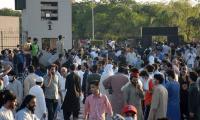KARACHI: The Supreme Court’s detailed reserved seats verdict has returned the PTI its mandate by reiterating that procedural formalities are not as important as the protection of the right to vote, say legal experts who also feel that the inclusion of the clarification order in the detailed verdict was acceptable.
An opposing view, however, feels that including the PTI as a party to the case is a step without precedent and goes beyond Article 185’s scope. One way out, say constitutional experts, could be for the SC to hear the review petitions filed against the July 12 verdict.
On Monday, the Supreme Court of Pakistan released a detailed verdict on its July 12 order regarding the allocation of reserved seats for women and minorities. The 70-page judgment, authored by Justice Mansoor Ali Shah, clarified that the PTI, despite being denied its election symbol due to irregularities in intra-party polls, remains a political party and can contest elections; criticized the ECP for listing PTI candidates as independents; and also criticized two dissenting judges.
For high court advocate Hassan Abdullah Niazi, “The majority has correctly utilized its constitutional power under Article 187 to do ‘complete justice’ to correct the series of errors made by the ECP and return the PTI its mandate.”He explains that the “majority’s entire reasoning flows from its interpretation of Article 17”, calling it important since that would mean that the Election Act amendments by the government ‘cannot frustrate the implementation of the court’s verdict.”
PILDAT President Ahmed Bilal Mehboob spoke with Geo News shortly after the verdict and questioned that, since it seemed like the Supreme Court had become almost a party to this whole situation, who will now decide on this whole situation? One way out, said Mehboob, would be for the apex court to start hearing the review petitions that were filed by the ECP and the PML-N against the July 12 verdict. “Perhaps through the review petition and through a full court, some clarity will come regarding the judgment. It could even end in some judges changing their view; that can happen as well.”
Calling the verdict a “history-defining moment for representative democracy”, Barrister Ali Tahir says its most important part “is in the reiteration of the principles that the procedural formalities do not carry much weight where the court’s concern is the protection of the right of vote of the electorate guaranteed under Articles 17(2) and 19 of the constitution, more than the right of any political party.”
How the court seems to have reached its reasoning is explained by lawyer Salaar Khan who first explains how “for alleged irregularities with its intra-party elections, the PTI was stripped of its party symbol. This is the penalty that the relevant law prescribes.”
He adds that the critics of the short order suggested that two things happen in addition to this: “first, the PTI’s candidates not be allowed to contest the election as candidates of the PTI....and second, that the seats won ought to have been given to the SIC, as the PTI was not even a party before the court.”
The detailed judgment, according to Khan, explains that the law does not provide for disallowing PTI candidates from contesting since “a political party continues to retain other constitutional rights”. The second issue -- that of the PTI not being a party before the court -- was “always a technical objection, not a principled one”, he adds, arguing that the court “appropriately, responds on both planes.”
“The majority judgment is grounded in basic democratic principles, and the right of the electorate to have a legislature that represents them. Any other interpretation would have engineered a two-thirds majority for the ruling alliance by way of a post-election exercise”, says Barrister Rida Hosain.
For Hosain, the most damning aspects of the judgment “are the findings regarding the ECP’s conduct”, and the findings of the court raise questions “regarding the entire electoral process”.
Not everyone agrees though. On Geo News, Advocate Raja Khalid Mehmood was of the opinion that the “PTI did not contest the elections like the Sunni Ittehad Council and that there is no precedent to interpret the law in such a way as to give relief to a party which is not a party in the election.”
Mehmood outlined the procedural steps involved to do something like this, adding that the way the July 12 verdict went about it was completely without any precedent, adding that the “bench has gone well beyond Article 185”.
Reiterating that the government’s argument regarding the amendments to the Election Act trumping the judgment is flawed, Salaar Khan argues that “not only is this judgment an interpretation of the constitution, which trumps ordinarily legislation, but the date from which these candidates are to be considered members of the PTI precedes the date the amendments were passed.”
Another interesting aspect is pointed out by Niazi, who says that the court “has declared the explanation to Rule 94 of the Election Rules to be unconstitutional.”
And what is Rule 94? Niazi explains that the rule provides the procedure for allocating a party’s share of reserved seats: “Its explanation excluded a political party lacking an electoral symbol from being allocated this share. The court found this provision to be an unreasonable restriction on the rights of political parties, therefore removing another objection that the ECP had relied on to deny PTI its reserved seats.”
The News also asked the legal experts whether a detailed judgment can include comments on dissenting judges or on a clarification order that was released after the pronouncement of the short order.
Barrister Ali Tahir says it is acceptable for the court to include a clarification order in its detailed judgment: “The majority’s short order clearly stated that the parties could come before it for clarification and the ECP wasted no time in seeking such clarification rather than obeying the order (which remains unobeyed to this day), having taken it up and passed an order, the majority opinion was completely justified to have made it a part of their judgment which it states shall also be read as part of this judgment – for otherwise a piece of the puzzle would have remained missing.”
Khan agrees there is “nothing untoward about a reference to [a clarification order], or its inclusion, in the detailed judgment.” Conceding that it did happen after the short order was pronounced, he adds that this is not the same thing as “for instance, commenting on parliament’s subsequent legislation on the same subject matter.”
On the matter of whether the detailed verdict should or could have tackled the dissenting notes, Niazi says that a response was not only expected but “warranted”. He adds that “a detailed judgment rebutting arguments made in a dissenting opinion is nothing unusual, and is a common practice in most common law jurisdictions and almost a routine occurrence within the American Supreme Court where judges often trade barbs in their respective opinions.”
That said, Niazi says that it is “highly unfortunate that we are seeing such a highly public spat take place between Supreme Court judges at a time when the country needs a united court more than ever”, cautioning that the divide within the court will “grow wider after this decision.”
In fact, per Salaar Khan, what was far from ordinary was the dissent itself, seeing as it “effectively urged disobeying an order of the majority of a thirteen-member bench of the highest court.” Regardless, says he, “the majority’s response remains confined to how the minority expressed its disagreement: I do not see it as a comment on the judges themselves.”
Justice Abdul Shakoor Paracha fixes hearing on December 24 regarding Islamabad constituencies
Police made one arrest after vehicle drove “at least 400 metres across the Christmas market”
Incident occurred when couple, along with their child, was travelling in their car
Congress party dismisses incident as political gimmick
"I am sure once negotiations start, things will move forward," says NA speaker
Discussion focuses on enhancing governance, accountability and functional autonomy within police







